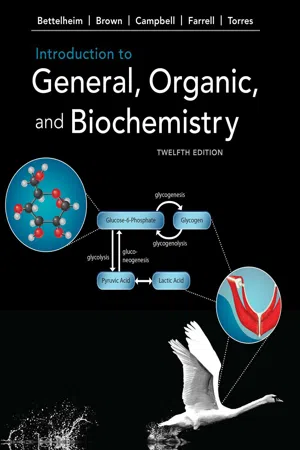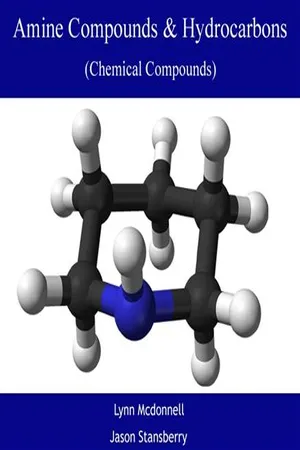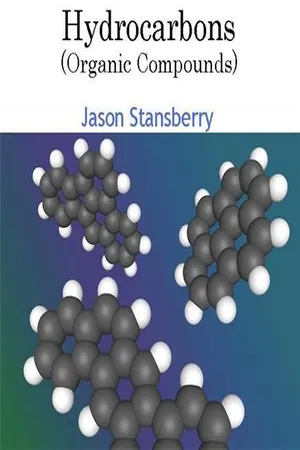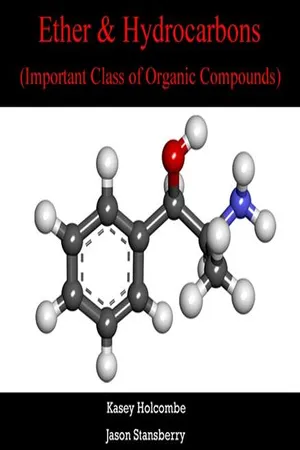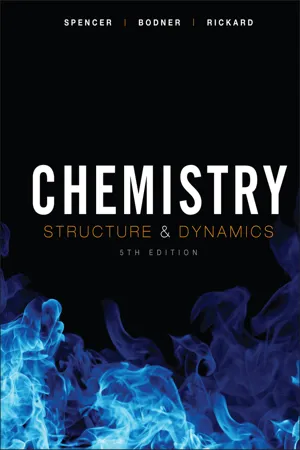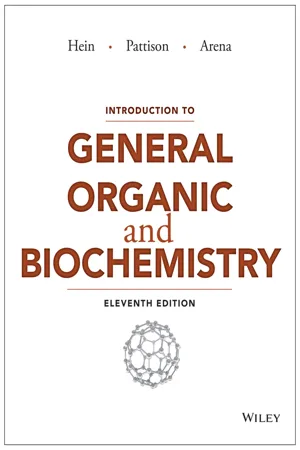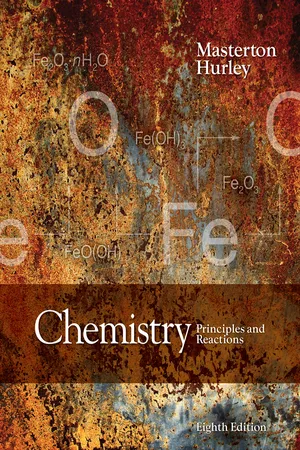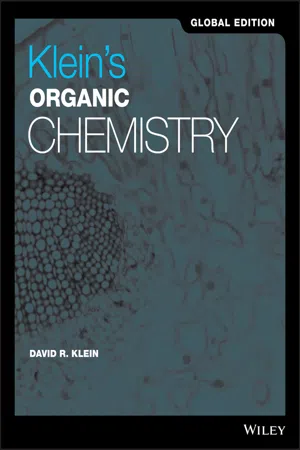Chemistry
Alkanes
Alkanes are a family of hydrocarbons consisting of carbon and hydrogen atoms linked by single bonds. They are known for their saturated structure, meaning they contain the maximum number of hydrogen atoms possible. Alkanes are commonly used as fuels and are important in organic chemistry due to their stability and lack of reactivity.
Written by Perlego with AI-assistance
11 Key excerpts on "Alkanes"
- Frederick Bettelheim, William Brown, Mary Campbell, Shawn Farrell(Authors)
- 2019(Publication Date)
- Cengage Learning EMEA(Publisher)
316 Alkanes 11 CONTENTS 11.1 Introduction to Alkanes 11.2 Writing Structural Formulas of Alkanes 11.3 Constitutional Isomers 11.4 Naming Alkanes 11.5 Obtaining Alkanes 11.6 CycloAlkanes 11.7 Shapes of Alkanes and CycloAlkanes How to . . . Draw Alternative Chair Conformations of Cyclohexane 11.8 Cis-Trans Isomerism in CycloAlkanes 11.9 Physical Properties of Alkanes and CycloAlkanes 11.10 Characteristic Reactions of Alkanes 11.11 Some Important HaloAlkanes 11.1 Introduction to Alkanes In this chapter, we examine the physical and chemical properties of Alkanes , the simplest type of organic compounds. Actually, Alkanes are members of a larger class of organic compounds called hydrocarbons. A hydrocarbon is a compound composed of only carbon and hydrogen. Figure 11.1 shows the four classes of hydrocarbons, along with the characteristic type of bonding be-tween carbon atoms in each class. Alkanes are saturated hydrocarbons ; that is, they contain only carbon–carbon single bonds. Saturated in this con-text means that each carbon in the hydrocarbon has the maximum num-ber of hydrogens bonded to it. A hydrocarbon that contains one or more carbon–carbon double bonds, triple bonds, or benzene rings is classified as an unsaturated hydrocarbon . We study Alkanes (saturated hydrocarbons) in this chapter, and alkenes, alkynes, and arenes (unsaturated hydrocar-bons) in Chapter 12. We often refer to Alkanes as aliphatic hydrocarbons because the phys-ical properties of the higher members of this class resemble those of the long carbon-chain molecules we find in animal fats and plant oils (Greek: aleiphar , fat or oil).- No longer available |Learn more
- (Author)
- 2014(Publication Date)
- Research World(Publisher)
____________________ WORLD TECHNOLOGIES ____________________ Chapter-7 Alkane Chemical structure of methane, the simplest alkane Alkanes (also known as paraffins or saturated hydrocarbons ) are chemical compounds that consist only of the elements carbon (C) and hydrogen (H) (i.e., hydrocarbons), wherein these atoms are linked together exclusively by single bonds (i.e., they are saturated compounds). Alkanes belong to a homologous series of organic compounds in which the members differ by a constant relative molecular mass of 14. ____________________ WORLD TECHNOLOGIES ____________________ Each carbon atom must have 4 bonds (either C-H or C-C bonds), and each hydrogen atom must be joined to a carbon atom (H-C bonds). A series of linked carbon atoms is known as the carbon skeleton or carbon backbone. In general, the number of carbon atoms is often used to define the size of the alkane (e.g., C 2 -alkane). An Alkyl group, generally abbreviated with the symbol R, is a functional group or side-chain that, like an alkane, consists solely of single-bonded carbon and hydrogen atoms, for example a methyl or ethyl group. The simplest possible alkane (the parent molecule) is methane, CH 4 . There is no limit to the number of carbon atoms that can be linked together, the only limitation being that the molecule is acyclic, is saturated, and is a hydrocarbon. Saturated oils and waxes are examples of larger Alkanes where the number of carbons in the carbon backbone tends to be greater than 10. Alkanes are not very reactive and have little biological activity. Alkanes can be viewed as a molecular tree upon which can be hung the interesting biologically active/reactive portions (functional groups) of the molecule. - No longer available |Learn more
- (Author)
- 2014(Publication Date)
- Academic Studio(Publisher)
________________________ WORLD TECHNOLOGIES ________________________ Chapter 10 Alkane Chemical structure of methane, the simplest alkane Alkanes (also known as paraffins or saturated hydrocarbons ) are chemical compounds that consist only of the elements carbon (C) and hydrogen (H) (i.e., hydrocarbons), wherein these atoms are linked together exclusively by single bonds (i.e., they are saturated compounds). Alkanes belong to a homologous series of organic compounds in which the members differ by a constant relative molecular mass of 14. Each carbon atom must have 4 bonds (either C-H or C-C bonds), and each hydrogen atom must be joined to a carbon atom (H-C bonds). A series of linked carbon atoms is known as the carbon skeleton or carbon backbone. In general, the number of carbon atoms is often used to define the size of the alkane (e.g., C 2 -alkane). An alkyl group, generally abbreviated with the symbol R, is a functional group or side-chain that, like an alkane, consists solely of single-bonded carbon and hydrogen atoms, for example a methyl or ethyl group. The simplest possible alkane (the parent molecule) is methane, CH 4 . There is no limit to the number of carbon atoms that can be linked together, the only limitation being that the molecule is acyclic, is saturated, and is a hydrocarbon. Saturated oils and waxes are ________________________ WORLD TECHNOLOGIES ________________________ examples of larger Alkanes where the number of carbons in the carbon backbone tends to be greater than 10. Alkanes are not very reactive and have little biological activity. Alkanes can be viewed as a molecular tree upon which can be hung the interesting biologically active/reactive portions (functional groups) of the molecule. - No longer available |Learn more
- (Author)
- 2014(Publication Date)
- Research World(Publisher)
________________________ WORLD TECHNOLOGIES ________________________ Chapter- 3 Alkane Chemical structure of methane, the simplest alkane Alkanes (also known as paraffins or saturated hydrocarbons ) are chemical compounds that consist only of the elements carbon (C) and hydrogen (H) (i.e., hydrocarbons), wherein these atoms are linked together exclusively by single bonds (i.e., they are saturated compounds). Alkanes belong to a homologous series of organic compounds in which the members differ by a constant relative molecular mass of 14. Each carbon atom must have 4 bonds (either C-H or C-C bonds), and each hydrogen atom must be joined to a carbon atom (H-C bonds). A series of linked carbon atoms is known as the carbon skeleton or carbon backbone. In general, the number of carbon atoms is often used to define the size of the alkane (e.g., C 2 -alkane). An alkyl group, generally abbreviated with the symbol R, is a functional group or side-chain that, like an alkane, consists solely of single-bonded carbon and hydrogen atoms, for example a methyl or ethyl group. ________________________ WORLD TECHNOLOGIES ________________________ The simplest possible alkane (the parent molecule) is methane, CH 4 . There is no limit to the number of carbon atoms that can be linked together, the only limitation being that the molecule is acyclic, is saturated, and is a hydrocarbon. Saturated oils and waxes are examples of larger Alkanes where the number of carbons in the carbon backbone tends to be greater than 10. Alkanes are not very reactive and have little biological activity. Alkanes can be viewed as a molecular tree upon which can be hung the interesting biologically active/reactive portions (functional groups) of the molecule. - No longer available |Learn more
- (Author)
- 2014(Publication Date)
- Academic Studio(Publisher)
________________________ WORLD TECHNOLOGIES ________________________ Chapter 10 Alkane Chemical structure of methane, the simplest alkane Alkanes (also known as paraffins or saturated hydrocarbons ) are chemical compounds that consist only of the elements carbon (C) and hydrogen (H) (i.e., hydrocarbons), wherein these atoms are linked together exclusively by single bonds (i.e., they are satura-ted compounds). Alkanes belong to a homologous series of organic compounds in which the members differ by a constant relative molecular mass of 14. Each carbon atom must have 4 bonds (either C-H or C-C bonds), and each hydrogen atom must be joined to a carbon atom (H-C bonds). A series of linked carbon atoms is known as the carbon skeleton or carbon backbone. In general, the number of carbon atoms is often used to define the size of the alkane (e.g., C 2 -alkane). An alkyl group, generally abbreviated with the symbol R, is a functional group or side-chain that, like an alkane, consists solely of single-bonded carbon and hydrogen atoms, for example a methyl or ethyl group. The simplest possible alkane (the parent molecule) is methane, CH 4 . There is no limit to the number of carbon atoms that can be linked together, the only limitation being that the molecule is acyclic, is saturated, and is a hydrocarbon. Saturated oils and waxes are ________________________ WORLD TECHNOLOGIES ________________________ examples of larger Alkanes where the number of carbons in the carbon backbone tends to be greater than 10. Alkanes are not very reactive and have little biological activity. Alkanes can be viewed as a molecular tree upon which can be hung the interesting biologically active/reactive portions (functional groups) of the molecule. - eBook - PDF
Chemistry
Structure and Dynamics
- James N. Spencer, George M. Bodner, Lyman H. Rickard(Authors)
- 2011(Publication Date)
- Wiley(Publisher)
The Alkanes in Table 16.2 are therefore known as straight-chain hydrocarbons in which the carbon atoms form a chain that runs from one end of the molecule to the other. The generic formula for these compounds can be understood by assuming that they contain chains of CH 2 groups with an additional hydrogen atom capping either end of the chain. Thus, for every n carbon atoms there must be 2n 2 hydrogen atoms: C n H 2n2 . C C H H H H H H H H - } C - } - } C C H H H H H H C H H H H - } C - } - } - } Propane Butane 16.2 THE SATURATED HYDROCARBONS OR Alkanes 727 Table 16.2 The Saturated Hydrocarbons, or Alkanes Molecular Melting Boiling State Name Formula Point ( o C) Point ( o C) at 25 o C Methane CH 4 182.5 162 gas Ethane C 2 H 6 183.3 88.6 gas Propane C 3 H 8 189.7 42.1 gas Butane C 4 H 10 138.4 0.5 gas Pentane C 5 H 12 129.7 36.1 liquid Hexane C 6 H 14 95 69.0 liquid Heptane C 7 H 16 90.6 98.4 liquid Octane C 8 H 18 56.8 125.7 liquid Nonane C 9 H 20 53.5 150.8 liquid Decane C 10 H 22 29.7 174.1 liquid Undecane C 11 H 24 24.6 195.9 liquid Dodecane C 12 H 26 9.6 216.3 liquid Eicosane C 20 H 42 36.8 343.8 solid Triacontane C 30 H 62 65.8 449.7 solid The four-carbon alkane is butane, with the formula C 4 H 10 . Butane A O O A C H C H H A O A C H H A O A C H H A O A H H H A O O A C H C H H A O A C H H A O A H H H Propane Alkanes also form branched structures. The smallest hydrocarbon in which a branch can occur has four carbon atoms. This compound has the same formula as butane (C 4 H 10 ), but a different structure. Compounds with the same formula and different structures are known as isomers (from the Greek isos, “equal,” and meros, “parts”). When it was first discovered, the branched isomer with the for- mula C 4 H 10 was therefore given the name isobutane. Isomers, such as butane and isobutane, that differ in the way the atoms are connected are called constitutional isomers because they literally differ in their constitution. - Morris Hein, Scott Pattison, Susan Arena, Leo R. Best(Authors)
- 2014(Publication Date)
- Wiley(Publisher)
The fossil fuels provide a rich resource of hydrocarbons for human society. In the past, these resources have been used primarily as a source of heat (via combustion). We now see that extensive combustion can have severe environmental consequences (e.g., air pollution and global warming). Fossil fuels also serve as the raw materials for much of today’s chemical industry. One theme that runs through the study of organic chemistry is the synthetic relationship between com- pounds; for example, acids are often formed from alcohols. Fossil fuels are the starting materials for many of these synthetic sequences. And, in the long run, the fossil fuels may well prove to be more valuable to us as a source of organic chemicals than as a source of heat. 19.5 SATURATED HYDROCARBONS: Alkanes Carefully define and describe alkane and learn the names and formulas for the first ten Alkanes. The Alkanes, also known as paraffins or saturated hydrocarbons, are open- or branched-chain hydrocarbons with only single covalent bonds between the carbon atoms. We will study the Alkanes in some detail because many other classes of organic compounds can be considered as derivatives of these substances. For example, it is necessary to learn the names of the first 10 members of the alkane series because these names are used as a basis for naming other classes of compounds. Methane, CH 4 , is the first member of the alkane series. Alkanes with two-, three-, and four-carbon atoms are ethane, propane, and butane, respectively. The names of the first four Alkanes are of common or trivial origin and must be memorized, but the names beginning with the fifth member, pentane, are derived from Greek numbers and are relatively easy to recall. The names and formulas of the first 10 members of the series are given in Table 19.4.- eBook - PDF
Chemistry for Today
General, Organic, and Biochemistry
- Spencer Seager, Michael Slabaugh, Maren Hansen, , Spencer Seager, Spencer Seager, Michael Slabaugh, Maren Hansen(Authors)
- 2021(Publication Date)
- Cengage Learning EMEA(Publisher)
Draw the structural formula for cis-1,2-dichlorocyclobutane. Copyright 2022 Cengage Learning. All Rights Reserved. May not be copied, scanned, or duplicated, in whole or in part. Due to electronic rights, some third party content may be suppressed from the eBook and/or eChapter(s). Editorial review has deemed that any suppressed content does not materially affect the overall learning experience. Cengage Learning reserves the right to remove additional content at any time if subsequent rights restrictions require it. Organic Compounds: Alkanes 357 11.10 Physical Properties of Alkanes Learning Objective 11 Describe the key physical properties of Alkanes. Since Alkanes are composed of nonpolar carbon–carbon and carbon–hydrogen bonds, they are nonpolar molecules. Alkanes have lower melting and boiling points than other organic compounds of comparable molecular weight (see Table 11.8). This is because their nonpolar molecules exert very weak attractions for each other. Alkanes are odorless compounds. The normal, or straight-chain, Alkanes make up what is called a homologous series. This term describes any series of compounds in which each member differs from a previ- ous member only by having an additional iCH 2 i unit. The physical and chemical prop- erties of compounds making up a homologous series are usually closely related and vary in a systematic and predictable way. For example, the boiling points of normal Alkanes increase smoothly as the length of the carbon chain increases (see Figure 11.25). This pat- tern results from increasing dispersion forces as molecular weight increases. At ordinary temperatures and pressures, normal Alkanes with 1 to 4 carbon atoms are gases, those with 5 to 20 carbon atoms are liquids, and those with more than 20 carbon atoms are waxy sol- ids (see Figure 11.26). Because they are nonpolar, Alkanes and other hydrocarbons are insoluble in water, which is a highly polar solvent. They are also less dense than water and thus float on it. - eBook - PDF
Chemistry
Principles and Reactions
- William Masterton, Cecile Hurley(Authors)
- 2020(Publication Date)
- Cengage Learning EMEA(Publisher)
■ ■ the phenomenon of isomerism, which is very common among organic com-pounds. This topic is introduced in Section 22-1 but discussed more generally in Section 22-5. ■ ■ different types of organic reactions (Section 22-6). Throughout this chapter, we will represent molecules by structural formulas, which show all the bonds present. Thus we have H 9 C 9 O 9 C 9 H H H H H ethanol H 9 C 9 C 9 H H H H H H 9 C 9 C 9 O 9 H H H H H ethane dimethyl ether To save space we often write condensed structural formulas such as CH 3 CH 3 CH 3 CH 2 OH CH 3 } O } CH 3 or C 2 H 6 or C 2 H 5 OH or (CH 3 ) 2 O 22-1 Saturated Hydrocarbons: Alkanes One large and structurally simple class of hydrocarbons includes those substances in which all the carbon-carbon bonds are single bonds. These are called saturated hydrocarbons , or Alkanes . In the Alkanes the carbon atoms are bonded to each other in chains, which may be long or short, straight or branched. The ratio of hydrogen to carbon atoms is a maximum in Alkanes, ▼ hence the term “saturated” hydrocarbon. The general formula of an alkane containing n carbon atoms is C n H 2 n 1 2 The simplest Alkanes are those for which n 5 1 (CH 4 ), n 5 2 (C 2 H 6 ), or n 5 3 (C 3 H 8 ): H 9 C 9 H H H H 9 C 9 C 9 H H H H H H 9 C 9 C 9 C 9 H H H H H H H methane ethane propane Around the carbon atoms in these molecules, and indeed in any saturated hydrocarbon, there are four single bonds involving sp 3 hybrid orbitals. As would be expected from the VSEPR model, these bonds are directed toward the corners of a regular tetrahedron. The bond angles are approximately 109.5 8 , the tetrahe-dral angle. This means that in propane (C 3 H 8 ) and in the higher Alkanes, the car-bon atoms are arranged in a “zigzag” pattern (Figure 22.1). The outer surfaces of these molecules contain mainly H atoms. CH 4 methane CH 3 CH 3 ethane CH 3 CH 2 CH 3 propane Figure 22.1 The three simplest Alkanes. - eBook - PDF
- David R. Klein(Author)
- 2020(Publication Date)
- Wiley(Publisher)
This chapter will introduce only the most basic principles of conformational analysis, which we will use to analyze the flexibility of molecules. To simplify our discussion, we will explore compounds that lack a functional group, called Alkanes and cycloAlkanes. Analysis of these compounds will enable us to understand how molecules achieve flexibility. Specifically, we will explore how Alkanes and cycloAlkanes change their three-dimensional shape as a result of the rota- tion of C C single bonds. Our discussion of conformational analysis will involve the comparison of many different compounds and will be more efficient if we can refer to compounds by name. A system of rules for naming Alkanes and cycloAlkanes will be developed prior to our discussion of molecular flexibility. 4.2 Nomenclature of Alkanes 133 4.1 INTRODUCTION TO Alkanes Recall that hydrocarbons are compounds comprised of only C and H; for example: C C H H H H H H Ethane C 2 H 6 C C H H H H Ethylene C 2 H 4 C C H H Acetylene C 2 H 2 Benzene C 6 H 6 Ethane is unlike the other examples in that it has no π bonds. Hydrocarbons that lack π bonds are called saturated hydrocarbons, or Alkanes. The names of these compounds usually end with the suffix “-ane,” as seen in the following examples: Propane Butane Pentane This chapter will focus on Alkanes, beginning with a procedure for naming them. The system of nam- ing chemical compounds, or nomenclature, will be developed and refined throughout the remaining chapters of this book. 4.2 NOMENCLATURE OF Alkanes An Introduction to IUPAC Nomenclature In the early nineteenth century, organic compounds were often named at the whim of their discover- ers. - eBook - PDF
- H. Stephen Stoker(Author)
- 2015(Publication Date)
- Cengage Learning EMEA(Publisher)
Cycloalkane nomenclature. The IUPAC name for a cycloalkane is obtained by placing the prefix cyclo - before the alkane name that corresponds to the number of carbon atoms in the ring. Alkyl groups attached to the ring are located by using a ring-numbering system (Section 1-13). Cis–trans isomerism. For certain disubstituted cycloAlkanes, cis–trans isomers exist. Cis–trans isomers are compounds that have the same molecular and structural formulas but different arrangements of atoms in space because of restricted rotation about bonds (Section 1-14). Natural sources of saturated hydrocarbons. Natural gas and petroleum are the largest and most important natural sources of both Alkanes and cycloAlkanes (Section 1-15). Physical properties of saturated hydrocarbons. Saturated hydrocarbons are not soluble in water and have lower densities than water. Melting and boiling points increase with increasing carbon chain length or ring size (Section 1-16). Chemical properties of saturated hydrocarbons. Two important reactions that saturated hydrocarbons undergo are combustion and halogenation. In combustion, saturated hydrocarbons burn in air to produce CO 2 and H 2 O. Halogenation is a substitution reaction in which one or more hydrogen atoms of the hydrocar-bon are replaced by halogen atoms (Section 1-17). Halogenated Alkanes. Halogenated Alkanes are hydrocarbon derivatives in which one or more halogen atoms have replaced hydrogen atoms of the alkane (Section 1-18). Halogenated alkane nomenclature. Halogenated Alkanes are named by using the rules that apply to branched-chain Alkanes, with halogen substituents being treated the same as alkyl groups (Section 1-18). Concepts to Remember Exercises and problems are arranged in matched pairs with the two members of a pair addressing the same concept(s). The answer to the odd-numbered member of a pair is given at the back of the book.
Index pages curate the most relevant extracts from our library of academic textbooks. They’ve been created using an in-house natural language model (NLM), each adding context and meaning to key research topics.
